Soil Physical–Hydraulic Properties in Different Rotational Silvopastoral Systems: A Short-Term Study
Abstract
:1. Introduction
2. Materials and Methods
2.1. Location and Description of the Study Area
2.2. Design and Conduction of the Experiment
2.3. Soil Sampling
2.4. Determination of Soil Water Retention Curve and Physical–Hydraulic Properties
2.5. Statistical Analysis
3. Results
4. Discussion
5. Conclusions
Author Contributions
Funding
Data Availability Statement
Acknowledgments
Conflicts of Interest
References
- ABIEC; Brazilian Beef Exporters Association. Beef Report 2023—Perfil da Pecuária no Brasil; ABIEC: Brasília, Brazil, 2024; 106p. [Google Scholar]
- Macedo, M.C.M.; Zimmer, A.H.; Kichel, A.N.; Giolo, R.A.; Araujo, A.A.R. Degradação de Pastagens, Alternativas de Recuperação e Renovação e Formas de Mitigação; Embrapa Gado de Corte: Campo Grande, Brazil, 2013; 42p. [Google Scholar]
- Silva, R.O.; Barioni, L.G.; Hall, J.A.J.; Moretti, A.C.; Veloso, R.F.; Alexander, P.; Crespolini, M.; Moran, D. Sustainable intensification of Brazilian livestock production through optimized pasture restoration. Agric. Syst. 2017, 153, 201–211. [Google Scholar] [CrossRef]
- Moraes, A.; de Faccio Carvalho, P.C.; Anghinoni, I.; Lustosa, S.B.C.; de Andrade Costa, S.E.V.G.; Kunrath, T.R. Integrated crop-livestock systems in the Brazilian subtropics. Eur. J. Agron. 2014, 57, 4–9. [Google Scholar] [CrossRef]
- Feltran-Barbieri, R.; Féres, J.G. Degraded pastures in Brazil: Improving livestock production and forest restoration. R. Soc. Open Sci. 2021, 8, 201854. [Google Scholar] [CrossRef]
- LAPIG. Laboratório de Processamento de Imagens e Geoprocessamento—Universidade Federal de Goiás (UFG) Atlas das Pastagens. 2022. Available online: https://atlasdaspastagens.ufg.br/map (accessed on 10 February 2024).
- Zhou, W.; Li, J.; Yue, T. Remote Sensing Monitoring and Evaluation of Degraded Grassland in China; Springer Geography: Singapore, 2020; pp. 125–138. [Google Scholar]
- Carvalho, W.T.V.; Minighin, D.C.; Gonçalves, L.C.; Villanova, D.F.Q.; Mauricio, R.M.; Pereira, R.V.G. Pastagens degradadas e técnicas de recuperação: Revisão. PUBVET 2017, 11, 1036–1045. [Google Scholar]
- Vásquez, H.V.; Puscán, M.M.H.; Bobadilla, L.G.; Zagaceta, H.; Valqui, L.; Maicelo, J.L.; Silva-López, J.O. Evaluation of pasture degradation through vegetation indices of the main livestock micro-watersheds in the Amazon region (NW Peru). Environ. Sustain. Ind. 2023, 20, 100315. [Google Scholar] [CrossRef]
- Simões, V.J.L.P.; de Souza, E.S.; Leite, M.L.M.; Souza, R.; Silva, J.R.I.; Sales, A.T.; Tabosa, J.N.; Lima, J.R.S.; Antonino, A.C.D. Physical-hydric attributes and soil CO2 efflux in pastoral systems in a Brazilian semi-arid environment. Agrofor. Syst. 2023, 97, 1421–1433. [Google Scholar] [CrossRef]
- Dexter, A.R. Advances in characterization of soil structure. Soil Tillage Res. 1988, 11, 199–238. [Google Scholar] [CrossRef]
- Li, X.; Hou, X.; Liu, Z.; Guo, F.; Din, Y.; Duan, J. Long-term overgrazing-induced changes in topsoil water-retaining capacity in a typical steppe. Rangel. Ecol. Manag. 2017, 70, 324–330. [Google Scholar] [CrossRef]
- Nascimento, D.M.; Cavalieri-Polizeli, K.M.V.; Silva, A.H.; Favaretto, N.; Parron, L.M. Soil physical quality under long-term integrated agricultural production systems. Soil Tillage Res. 2019, 110, 292–299. [Google Scholar] [CrossRef]
- Benevenute, P.A.N.; Morais, E.G.; Souza, A.; Vasques, I.C.F.; Cardoso, D.P.; Severiano, E.C.; Homem, B.G.C.; Casagrande, D.R.; Silva, B.M. Penetration resistance: An effective indicator for monitoring soil compaction in pastures. Ecol. Indic. 2020, 117, 106647. [Google Scholar] [CrossRef]
- Cherubin, M.R.; Chavarro-Bermeo, J.P.; Silva-Olaya, A.M. Agroforestry systems improve soil physical quality in northwestern Colombian Amazon. Agrofor. Syst. 2019, 93, 1741–1753. [Google Scholar] [CrossRef]
- Chará, J.; Jose, S. Silvopastoral Systems of Meso America and Northern South America; Springer International Publishing: Cham, Switzerland, 2023; 347p. [Google Scholar]
- Greenwood, K.L.; McKenzie, B.M. Grazing effects on soil physical properties and the consequences for pastures: A review. Aust. J. Exp. Agric. 2001, 41, 1231–1250. [Google Scholar] [CrossRef]
- Martha, G.B., Jr.; Alves, E.; Contini, E. Land-Saving approaches and beef production growth in Brazil. Agric. Syst. 2012, 110, 173–177. [Google Scholar] [CrossRef]
- Martinkoski, L.; Vogel, G.F.; Jadoski, S.O.; Watzlawick, L.F. Qualidade física do solo sob manejo silvipastoril e floresta secundária. Floresta Ambient. 2017, 24, e20160282. [Google Scholar] [CrossRef]
- Montagnini, F.; Somarriba, E.; Murgueitio, E.; Fassola, H.; Eibl, B. Sistemas Agroflorestales, Funciones Productivas, Socioeconomicas y Ambientales; Serie Técnica; Informe Técnico 402; CATIE, Turrialba, Costa Rica; Editorial CIPAV: Cali, Colombia, 2015; p. 454. [Google Scholar]
- Urruth, L.M.; Bassi, J.B.; Chemello, D. Policies to encourage agroforestry in the Southern Atlantic Forest. Land Use Policy 2022, 112, 105802. [Google Scholar] [CrossRef]
- Murgueitio, E.; Calle, Z.; Uribe, F.; Calle, A.; Solorio, B. Native trees and shrubs for the productive rehabilitation of tropical cattle ranching lands. For. Ecol. Manag. 2011, 261, 1654–1663. [Google Scholar] [CrossRef]
- Rivera, L.; Armbrecht, I.; Calle, Z. Silvopastoral systems and ant diversity conservation in a cattle-dominated landscape of the Colombian Andes. Agric. Ecosyst. Environ. 2013, 81, 188–194. [Google Scholar] [CrossRef]
- Lal, R.; Pierce, F.J. The vanishing resource. In Soil Management for Sustainability; Lal, R., Pierce, F.J., Eds.; Soil Water Conservation Society: Ankeny, IA, USA, 1991; pp. 1–5. [Google Scholar]
- Rachwal, M.F.G.; Dedecek, R.A.; Maia, C.M.B.F.; Parron, L.M. Uso e Manejo da terra e aspectos pedológicos na avaliação de serviços ambientais. In Serviços Ambientais em Sistemas Agrícolas e Florestais do Bioma Mata Atlântica; Parron, L.M., Garcia, J.R., Oliveira, E.B., Brown, G.G., Prado, R.B., Eds.; Embrapa: Brasília, Brasil, 2015; pp. 57–70. [Google Scholar]
- Reynolds, W.D.; Bowman, B.T.; Drury, C.F.; Tan, C.S.; Lu, X. Indicators of good soil physical quality: Density and storage parameters. Geoderma 2002, 110, 131–146. [Google Scholar] [CrossRef]
- Noordwijk, M.V.; Farida, S.P.; Agus, F.; Hairiah, K.; Suprayogo, D.; Verbist, B. Watershed functions in productive agricultural landscapes with trees. In World Agroforestry into the Future; Garrity, D., Okono, A., Grayson, M., Parrott, S., Eds.; World Agroforesty Centre: Nairobi, Kenya, 2006; pp. 103–112. [Google Scholar]
- Bargués Tobella, A.; Reese, H.; Almaw, A.; Bayala, J.; Malmer, A.; Laudon, H.; Ilstedt, U. The effect of trees on preferential flow and soil infiltrability in an agroforestry parkland in semiarid Burkina Faso. Water Resour. Res. 2014, 50, 2108–2123. [Google Scholar] [CrossRef]
- Peri, P.L.; Chará, J.; Viñoles, C.; Bussoni, A.; Cubbage, F. Current trends in silvopastoral systems. Agrofor. Syst. 2024, 98, 1945–1953. [Google Scholar] [CrossRef]
- Van Genuchten, M.T. A closed-form equation for predicting the hydraulic conductivity of unsaturated soils. Soil Sci. Soc. Am. J. 1980, 44, 892–898. [Google Scholar] [CrossRef]
- Dexter, A.R. Soil physical quality: Part I. Theory, Effects of soil texture, density, and organic matter, and effects on root growth. Geoderma 2004, 120, 201–214. [Google Scholar] [CrossRef]
- Dexter, A.R. Soil physical quality: Part III. Unsaturated hydraulic conductivity and general conclusions about S-theory. Geoderma 2004, 120, 227–239. [Google Scholar] [CrossRef]
- Aratani, R.G.; Freddi, O.S.; Centurion, J.F.; Andrioli, I. Physical quality of an Anionic Acrustox under different management systems. Rev. Bras. Ciênc. Solo 2009, 33, 677–687. [Google Scholar] [CrossRef]
- Carvalho Filho, A.; Carvalho, L.C.C.; Centurion, J.F.; Beutler, A.N.; Cortez, J.W.; Ribon, A.A. Qualidade física de um Latossolo Vermelho férrico sob sistemas de uso e manejo. Biosci. J. 2009, 25, 43–51. [Google Scholar]
- Al-Kayssi, A.W. Use of water retention data and soil physical quality index S to quantify hard-setting and degree of soil compactness indices of gypsiferous soils. Soil Tillage Res. 2021, 206, 104805. [Google Scholar] [CrossRef]
- Dlapa, P.; Hrinik, D.; Hrabovsky, A.; Simkovic, I.; Zarnovicano, H.; Sekucia, F.; Kollar, J. The impact of land-use on the hierarchical pore size loamy soils. Water 2020, 12, 339. [Google Scholar] [CrossRef]
- Luz, F.B.; Carvalho, M.L.; Borba, D.A.; Schiebelbein, B.E.; Lima, P.V.; Cherubin, M.R. Linking soil water changes to soil physical quality in sugarcane expansion areas in Brazil. Water 2020, 12, 3156. [Google Scholar] [CrossRef]
- Alvares, C.A.; Stape, J.L.; Sentelhas, P.C.; Gonçalves, J.L.M.; Sparovek, G. Köppen’s climate classification map for Brazil. Meteorol. Z. 2013, 22, 711–728. [Google Scholar] [CrossRef]
- Soil Survey Staff. Keys to Soil Taxonomy, 12th ed.; United States Department of Agriculture, Natural Resources Conservation Service: Washington, DC, USA, 2014; 372p.
- Teixeira, P.C.; Donagemma, G.K.; Fontana, A.; Teixeira, W.G. Manual de Métodos de Análise de Solos, 3rd ed.; Embrapa: Brasília, Brazil, 2017; 573p. [Google Scholar]
- Dourado-Neto, D.; Nielsen, D.R.; Hopmans, J.W.; Reichardt, K.; Bafchi, O. Programa para confecção da curva de retenção de água no solo, modelo Van Genuchten. Eng. Rural. 2001, 1, 92–102. [Google Scholar]
- Mualem, Y. A new model for predicting the hydraulic conductivity of unsaturated porous media. Water Resour. Res. 1976, 12, 513–522. [Google Scholar] [CrossRef]
- Khattree, R.; Naik, D.N. Multivariate Data Reduction and Discrimination with SAS Software; SAS Institute: Cary, NC, USA, 2000; 553p. [Google Scholar]
- Reichardt, K.; Dourado-Neto, D.; Timm, L.C.; Basanta, M.V.; Cavalcante, L.F.; Teruel, D.A.; Bafchi, O.O.S.; Tominaga, T.T.; Cerri, C.C.; Trivelin, P.C.O. The fate of organic matter in a sugarcane system in Brazil. In Management of Crop Residues for Sustainable Crop Production; IAEA-TECDOC–1354; IAEA: Vienna, Austria, 2003; pp. 149–169. [Google Scholar]
- Giarola, N.F.B.; Tormena, C.A.; Dutra, A.C. Physical degradation of a Red Latosol used for intensive forage production. Rev. Bras. Ciênc. Solo 2007, 31, 863–873. [Google Scholar] [CrossRef]
- Vasconcelos, R.F.B.; Souza, E.R.; Cantalice, J.R.B.; Silva, L.S. Qualidade física de Latossolo Amarelo de tabuleiros costeiros em diferentes sistemas de manejo da cana-de-açúcar. Rev. Bras. Eng. Agríc. Ambient. 2014, 18, 381–386. [Google Scholar] [CrossRef]
- Cardinael, R.; Chevallier, T.; Barthès, B.G.; Saby, N.P.; Parent, T.; Dupraz, C.; Bernoux, M.; Chenu, C. Impact of alley cropping agroforestry on stocks, forms and spatial distribution of soil organic carbon: A meta-analysis. Agric. Ecosyst. Environ. 2017, 240, 280–295. [Google Scholar]
- Pezzopane, J.R.M.; Martins, S.V.; Pezzopane, C.G.; Cecon, P.R.; Ferreira, D.F. Rooting depth and water extraction patterns of Leucaena leucocephala in silvopastoral systems. Agrofor. Syst. 2015, 89, 265–273. [Google Scholar]
- Fisher, R.F.; Jones, R.J.; Hughes, R.M. Tree Legumes for Improved Farming Systems in the Humid Tropics; CAB International: Wallingford, CT, USA, 1994. [Google Scholar]
- Shelton, H.M.; Franzel, S.; Peters, M. Legume shrubs and trees for forage in the tropics: Their management and development. Trop. Grassl. 2005, 39, 1–14. [Google Scholar]
- Jama, B.; Swinkels, R.A.; Hess, C.E. Tithonia diversifolia as a green manure for soil fertility improvement in western Kenya: A review. East Afr. Agric. For. J. 2000, 65, 97–107. [Google Scholar]
- Assis, P.C.R.; Stone, L.F.; Medeiros, J.C.; Oliveira, J.M.; Wruck, F.J.; Madari, B.E.; Heinemann, A.B. Atributos físicos, químicos e biológicos do solo em sistemas de integração lavoura-pecuária-floresta. Agrarian 2019, 12, 57–70. [Google Scholar] [CrossRef]
- Kopi, A.J.; Douglas, J.T. A rapid, inexpensive and quantitative procedure for assessing soil structure with respect to cropping. Soil Use Manag. 1991, 7, 52–56. [Google Scholar] [CrossRef]
- Baver, L.D.; Gardner, W.H.; Gardner, W.R. Soil Physics; John Wiley & Sons: New York, NY, USA, 1972; 498p. [Google Scholar]
- Castellini, M.; Stellafci, A.M.; Barca, E.; Iovino, M. Application of multivariate analysis techniques for selecting soil physical quality indicators: A case study in long-term field experiments in Apulia (Southern Italy). Soil Sci. Soc. Am. J. 2019, 83, 707–720. [Google Scholar] [CrossRef]
- Topp, G.C.; Reynolds, W.D.; Cook, F.J.; Kirby, J.M.; Carter, M.R. Physical attributes of soil quality. In Soil Quality for Crop Production and Ecosystem Health. Developments in Soil Science; Gregorich, E.G., Carter, M.R., Eds.; Elsevier: New York, NY, USA, 1997; pp. 21–58. [Google Scholar]
- Assouline, S.; Or, D. The concept of field capacity revisited: Defining intrinsic static and dynamic criteria for soil internal drainage dynamics. Water Resour. Res. 2014, 50, 4787–4802. [Google Scholar] [CrossRef]
- Suzuki, L.E.A.S.; Lima, C.L.R.; Reinert, D.J.; Reichert, J.M.; Pillon, C.M. Estrutura e armazenamento de água em um Argissolo sob pastagem cultivada, floresta nativa e povoamento de eucalipto no Rio Grande do Sul. Rev. Bras. Ciênc. Solo 2014, 38, 94–106. [Google Scholar] [CrossRef]
- Reichardt, K. A Água em Sistemas Agrícolas; Editora Manole Ltda: São Paulo, Brazil, 1990. [Google Scholar]
- Streck, C.A.; Reinert, D.J.; Reichert, J.M.; Horn, R. Relações do parâmetro S para algumas propriedades físicas de solos do sul do Brasil. Rev. Bras. Ciênc. Solo 2008, 32, 2603–2612. [Google Scholar] [CrossRef]
- Andrade, R.S.; Stone, L.F. S index as an indicator of physical quality of Brazilian ‘Cerrado’ soils. Rev. Bras. Eng. Agríc. Ambient. 2009, 13, 382–388. [Google Scholar] [CrossRef]
- Albuquerque, J.A.; Sangoi, L.; Ender, M. Efeito da integração lavoura-pecuária nas propriedades físicas do solo e características da cultura do milho. Rev. Bras. Ciênc. Solo 2001, 25, 717–723. [Google Scholar] [CrossRef]
- Barros, F.S.M.; Klutsch, J.G.; Moreira, F.M.S.; Franco, A.L.C.; Macedo, M.C.M.; Boddey, R.M. Soil physical quality and carbon stocks under integrated crop-livestock-forest systems in the Brazilian Cerrado. Agric. Ecosyst. Environ. 2019, 278, 21–29. [Google Scholar]
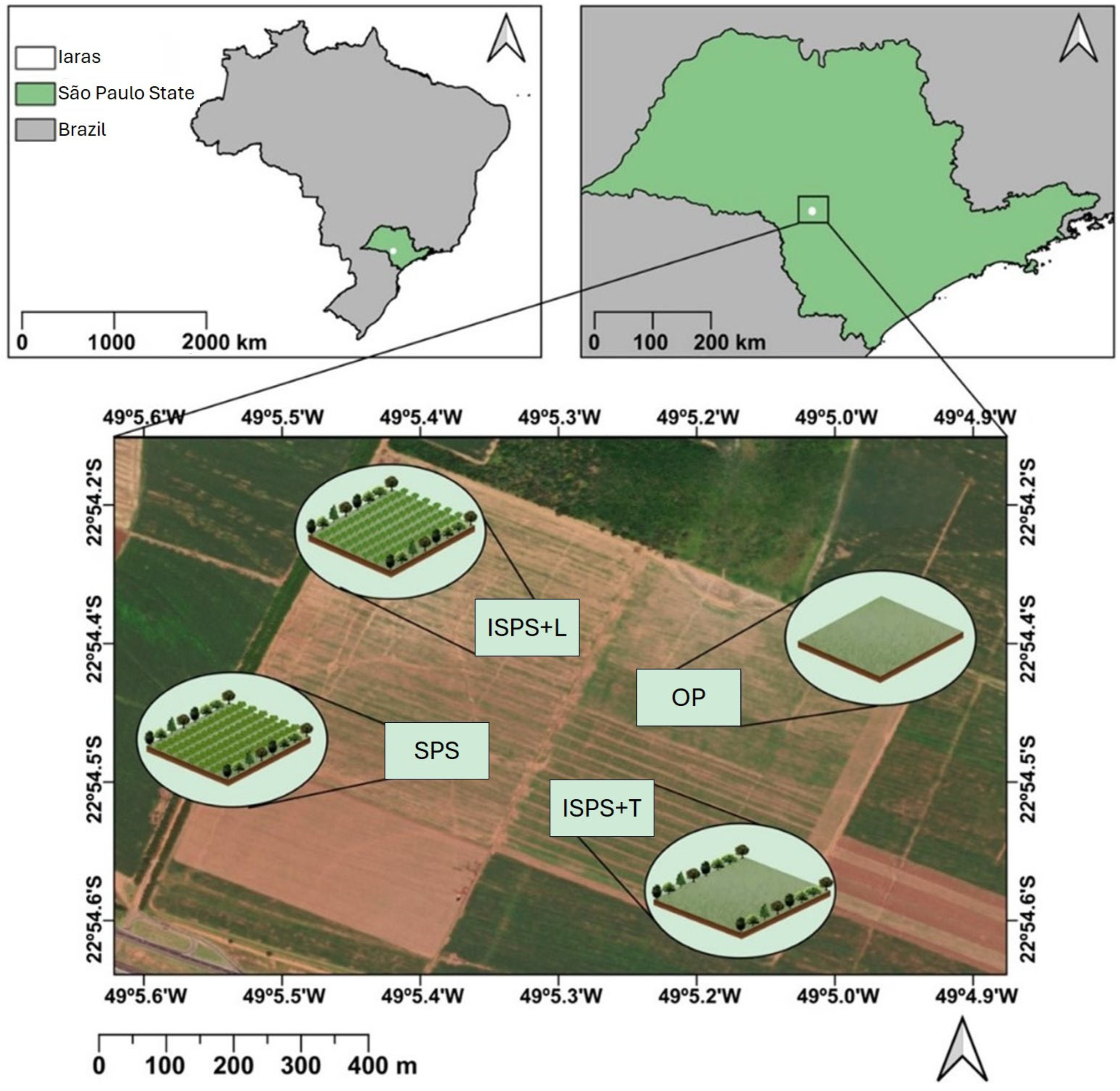
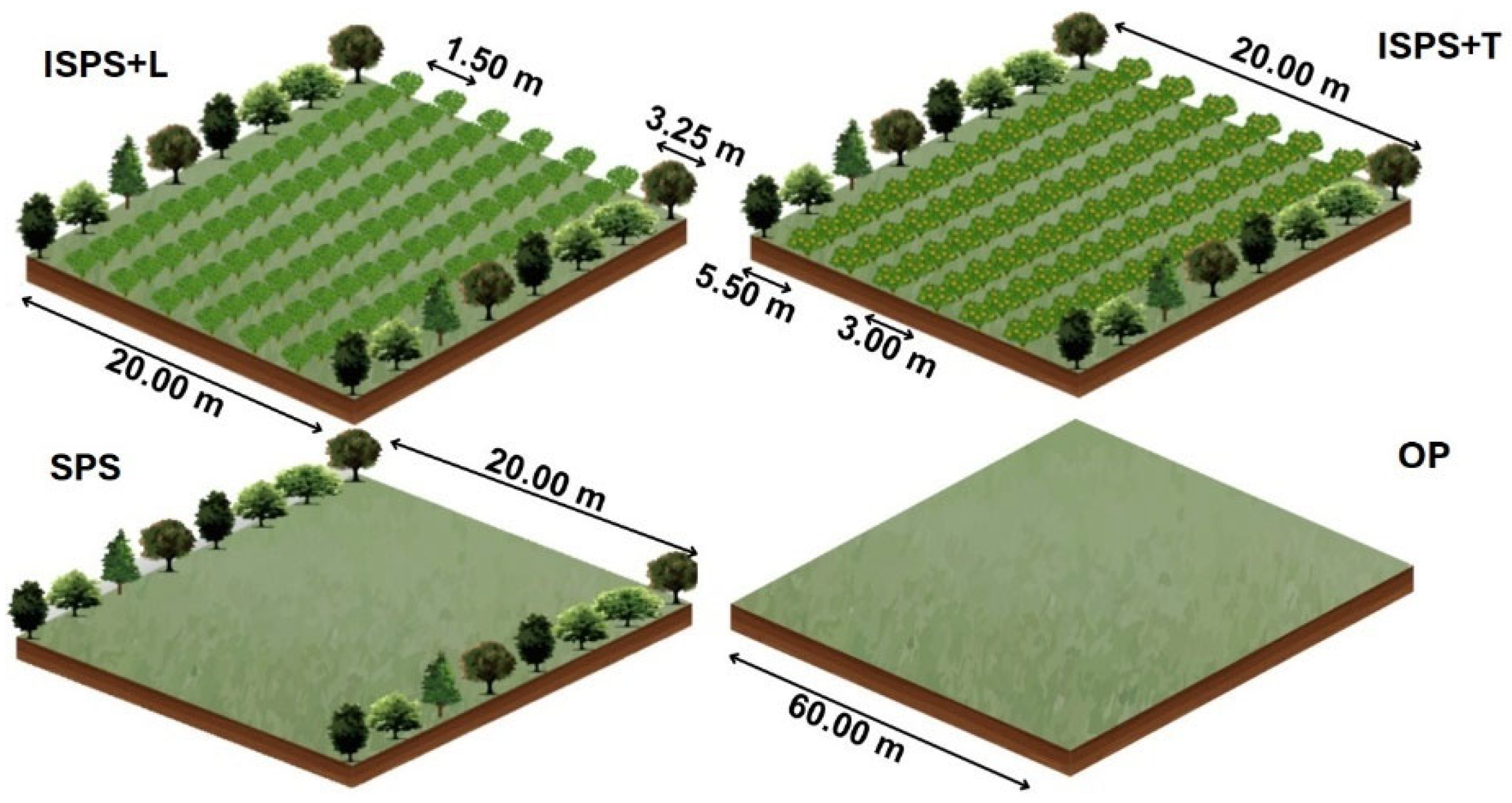
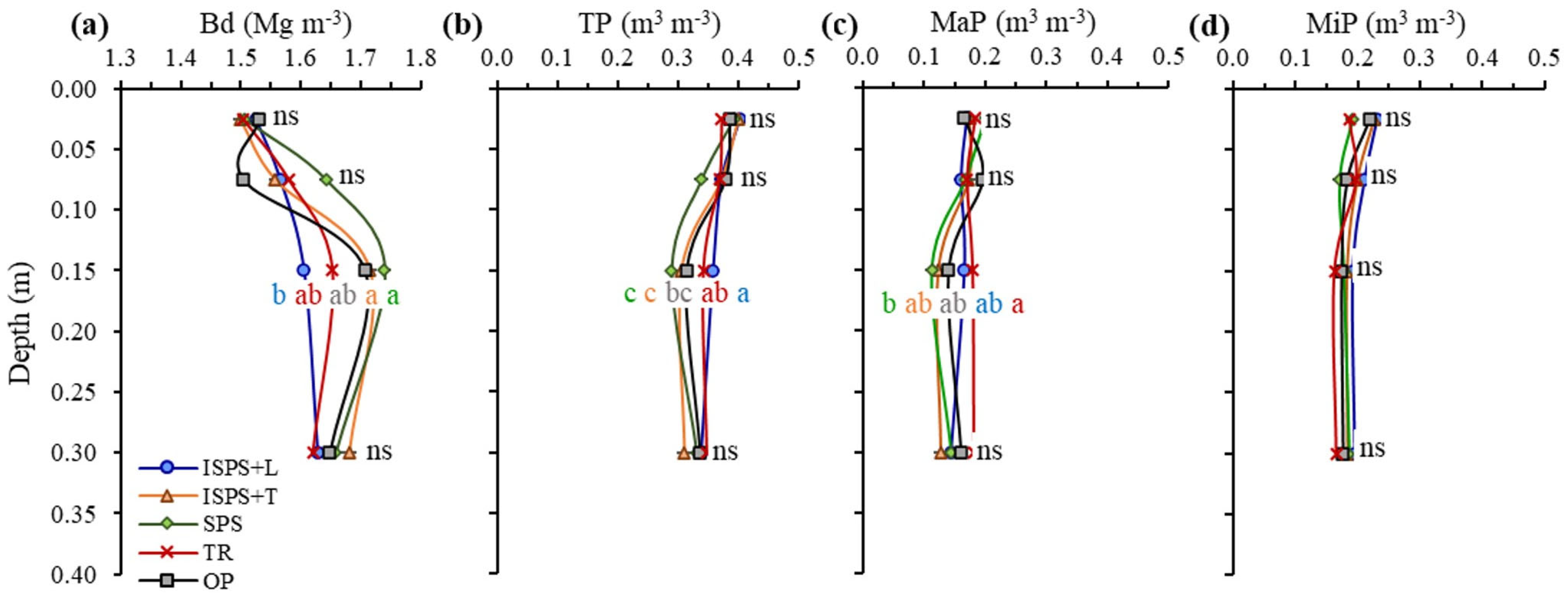
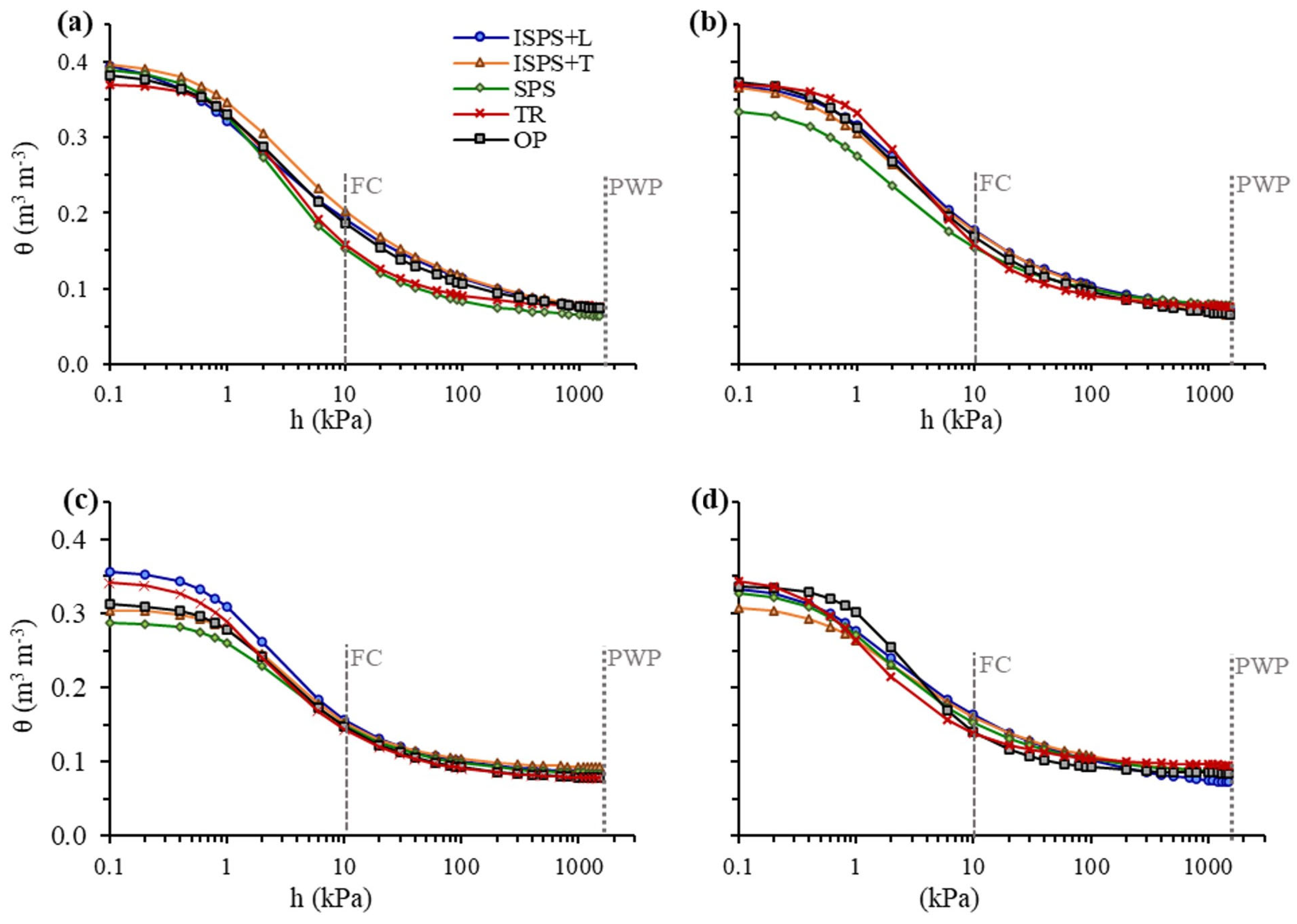
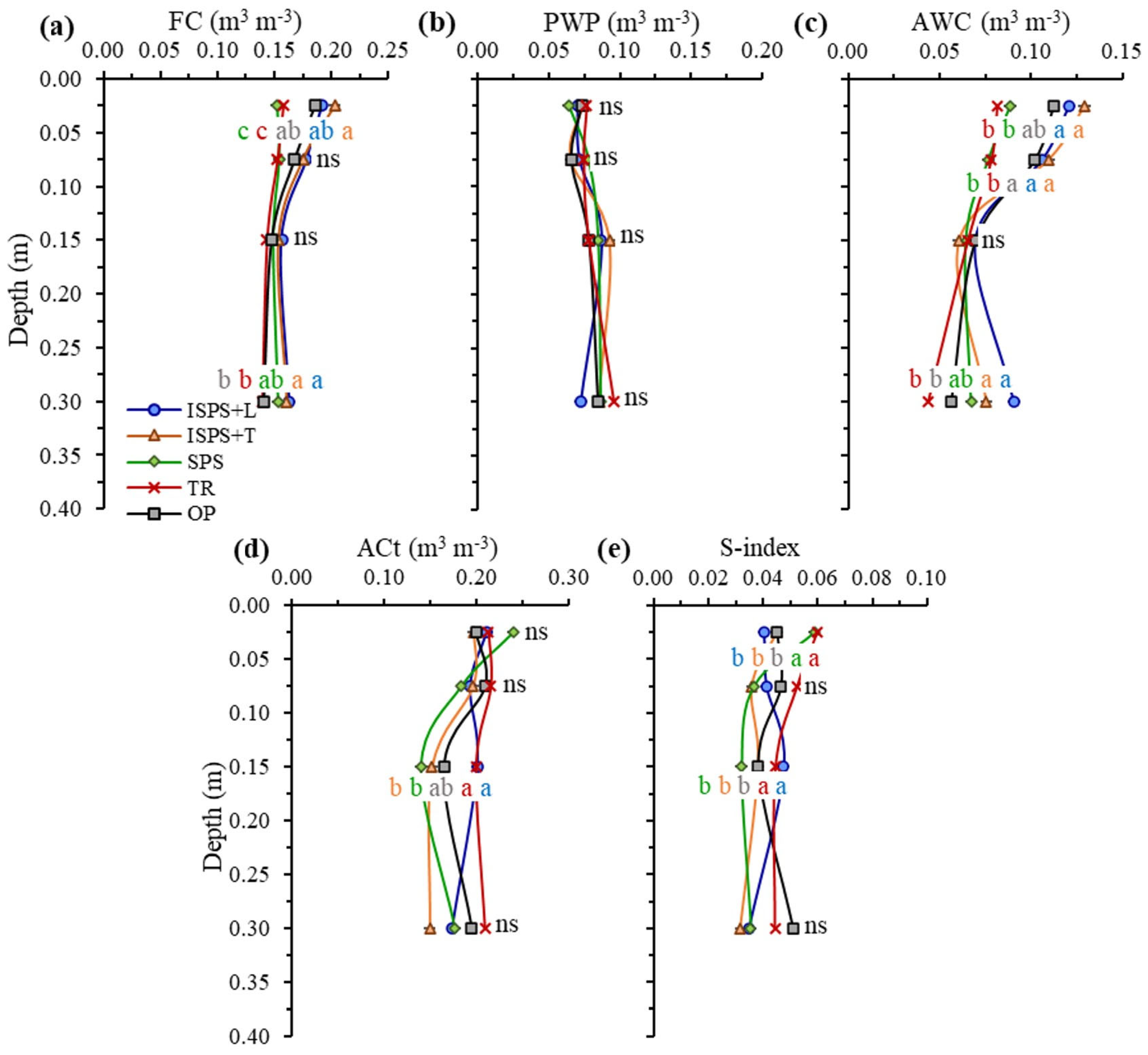

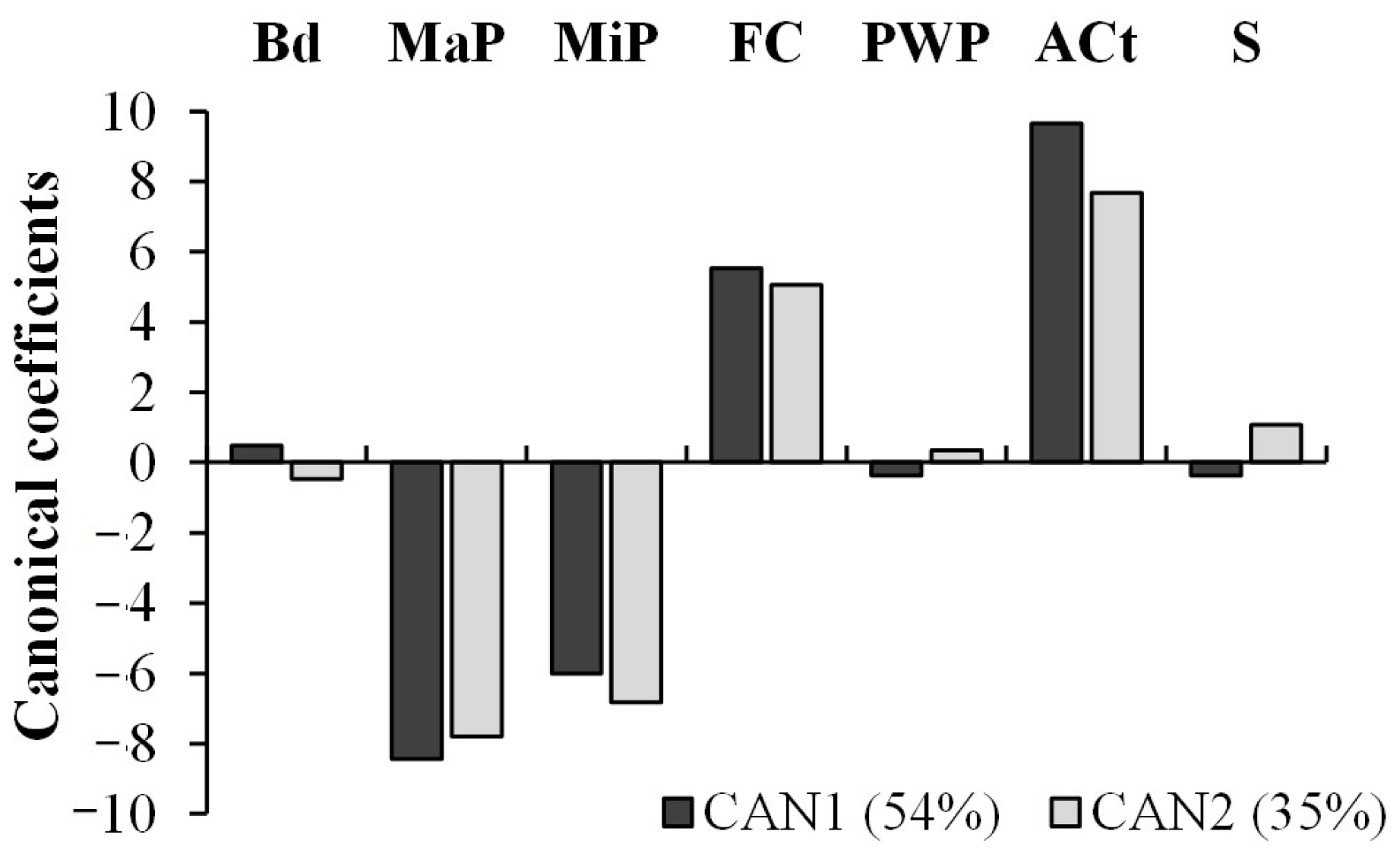

| Layers (m) | Sand (53–2000 µm) | Silt (2–53 µm) | Clay (<2 µm) | Texture |
|---|---|---|---|---|
| g kg−1 | ||||
| 0.00–0.05 | 824.5 | 45.9 | 129.6 | Loamy Sand |
| 0.05–0.10 | 820.6 | 49.1 | 130.3 | Loamy Sand |
| 0.10–0.20 | 825.6 | 43.9 | 130.6 | Loamy Sand |
| 0.20–0.30 | 820.9 | 46.8 | 132.2 | Loamy Sand |
| 0.30–0.70 | 821.0 | 45.9 | 133.1 | Loamy Sand |
| Soil Depth (m) | Treatment | Adjustment Parameters | R2 | ||||
|---|---|---|---|---|---|---|---|
| (m3 m−3) | (m3 m−3) | α (kPa−1) | m | n | |||
| 0.00–0.05 | ISPS + L | 0.037 | 0.402 | 1.629 | 0.235 | 1.307 | 0.966 |
| ISPS + T | 0.050 | 0.400 | 0.886 | 0.272 | 1.373 | 0.946 | |
| SPS | 0.059 | 0.392 | 0.834 | 0.373 | 1.594 | 0.955 | |
| OP | 0.058 | 0.385 | 0.884 | 0.299 | 1.425 | 0.971 | |
| TR | 0.074 | 0.371 | 0.584 | 0.413 | 1.705 | 0.919 | |
| 0.05–0.10 | ISPS + L | 0.057 | 0.371 | 0.934 | 0.297 | 1.422 | 0.960 |
| ISPS + T | 0.044 | 0.371 | 1.228 | 0.266 | 1.362 | 0.944 | |
| SPS | 0.069 | 0.338 | 1.194 | 0.315 | 1.461 | 0.947 | |
| OP | 0.053 | 0.377 | 1.030 | 0.306 | 1.440 | 0.958 | |
| TR | 0.071 | 0.368 | 0.743 | 0.389 | 1.637 | 0.926 | |
| 0.10–0.20 | ISPS + L | 0.084 | 0.357 | 0.759 | 0.393 | 1.648 | 0.932 |
| ISPS + T | 0.091 | 0.305 | 0.559 | 0.414 | 1.706 | 0.931 | |
| SPS | 0.081 | 0.289 | 0.627 | 0.375 | 1.601 | 0.958 | |
| OP | 0.075 | 0.313 | 0.656 | 0.383 | 1.620 | 0.965 | |
| TR | 0.075 | 0.343 | 0.875 | 0.385 | 1.625 | 0.960 | |
| 0.20–0.40 | ISPS + L | 0.056 | 0.337 | 1.287 | 0.272 | 1.374 | 0.970 |
| ISPS + T | 0.075 | 0.310 | 1.057 | 0.297 | 1.423 | 0.949 | |
| SPS | 0.080 | 0.330 | 1.161 | 0.332 | 1.497 | 0.955 | |
| OP | 0.084 | 0.336 | 0.595 | 0.451 | 1.823 | 0.971 | |
| TR | 0.094 | 0.348 | 1.416 | 0.394 | 1.651 | 0.942 | |
| Bd | TP | MaP | MiP | FC | PWP | AWC | ACt | S | |
|---|---|---|---|---|---|---|---|---|---|
| Bd | * | * | * | ns | * | ns | * | * | |
| TP | −0.826 | * | * | ns | * | ns | * | * | |
| MaP | −0.517 | 0.723 | * | * | * | * | * | * | |
| MiP | −0.318 | 0.254 | −0.484 | * | ns | * | ns | * | |
| FC | 0.126 | −0.110 | −0.403 | 0.426 | * | * | * | * | |
| PWP | 0.428 | −0.250 | −0.249 | 0.034 | 0.485 | ns | * | * | |
| AWC | −0.142 | 0.040 | −0.295 | 0.462 | 0.819 | −0.103 | * | * | |
| ACt | −0.762 | 0.905 | 0.794 | 0.034 | −0.522 | −0.419 | −0.319 | * | |
| S | −0.548 | 0.485 | 0.245 | 0.272 | −0.434 | −0.255 | −0.321 | 0.601 |
| PC1 | PC2 | |
|---|---|---|
| Eigenvalues | 4.138 | 1.969 |
| Explained variance (%) | 59.12 | 28.13 |
| Eigenvectors | ||
| Bd | −0.480 | 0.049 |
| MaP | 0.419 | 0.316 |
| MiP | 0.296 | −0.517 |
| FC | 0.277 | −0.569 |
| PWP | −0.364 | 0.189 |
| ACt | 0.433 | 0.296 |
| Index S | 0.332 | 0.429 |
| Correlation of the original variables with the principal components PC1 and PC2 | ||
| Bd | −0.98 * | 0.07 |
| MaP | 0.85 * | 0.44 |
| MiP | 0.60 * | −0.73 * |
| FC | 0.56 * | −0.80 * |
| PWP | −0.74 * | 0.27 |
| ACt | 0.88 * | 0.42 |
| Index S | 0.68 * | 0.60 * |
Disclaimer/Publisher’s Note: The statements, opinions and data contained in all publications are solely those of the individual author(s) and contributor(s) and not of MDPI and/or the editor(s). MDPI and/or the editor(s) disclaim responsibility for any injury to people or property resulting from any ideas, methods, instructions or products referred to in the content. |
© 2025 by the authors. Licensee MDPI, Basel, Switzerland. This article is an open access article distributed under the terms and conditions of the Creative Commons Attribution (CC BY) license (https://creativecommons.org/licenses/by/4.0/).
Share and Cite
Serrano Junior, O.V.; de Souza, Z.M.; Esteban, D.A.A.; Bezerra, L.P.; Guimarães, E.M.; de Lima, R.P.; Boechat, C.L.; da Silva, R.B. Soil Physical–Hydraulic Properties in Different Rotational Silvopastoral Systems: A Short-Term Study. Water 2025, 17, 1486. https://doi.org/10.3390/w17101486
Serrano Junior OV, de Souza ZM, Esteban DAA, Bezerra LP, Guimarães EM, de Lima RP, Boechat CL, da Silva RB. Soil Physical–Hydraulic Properties in Different Rotational Silvopastoral Systems: A Short-Term Study. Water. 2025; 17(10):1486. https://doi.org/10.3390/w17101486
Chicago/Turabian StyleSerrano Junior, Osvaldo Viu, Zigomar Menezes de Souza, Diego Alexander Aguilera Esteban, Leila Pires Bezerra, Euriana Maria Guimarães, Renato Paiva de Lima, Cácio Luiz Boechat, and Reginaldo Barboza da Silva. 2025. "Soil Physical–Hydraulic Properties in Different Rotational Silvopastoral Systems: A Short-Term Study" Water 17, no. 10: 1486. https://doi.org/10.3390/w17101486
APA StyleSerrano Junior, O. V., de Souza, Z. M., Esteban, D. A. A., Bezerra, L. P., Guimarães, E. M., de Lima, R. P., Boechat, C. L., & da Silva, R. B. (2025). Soil Physical–Hydraulic Properties in Different Rotational Silvopastoral Systems: A Short-Term Study. Water, 17(10), 1486. https://doi.org/10.3390/w17101486






